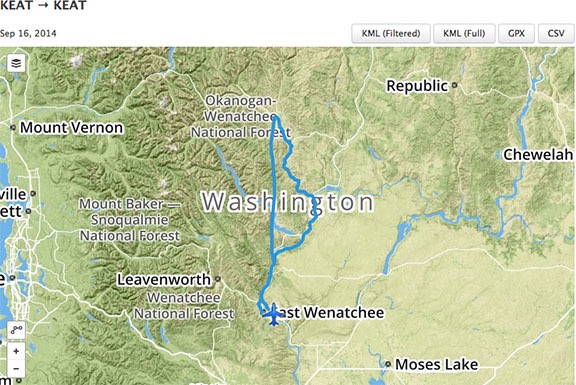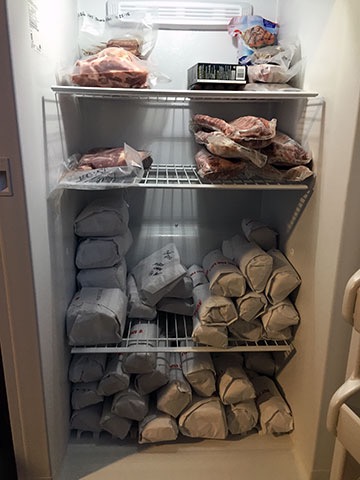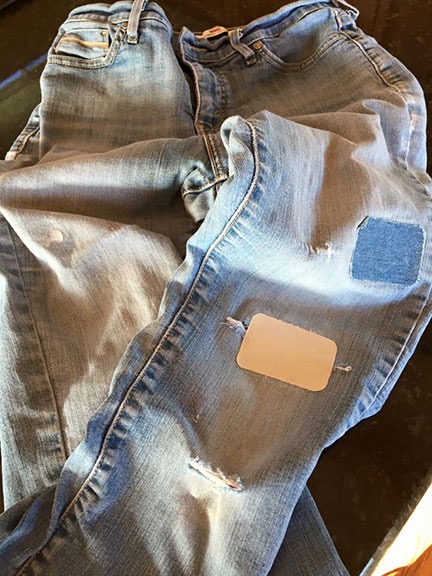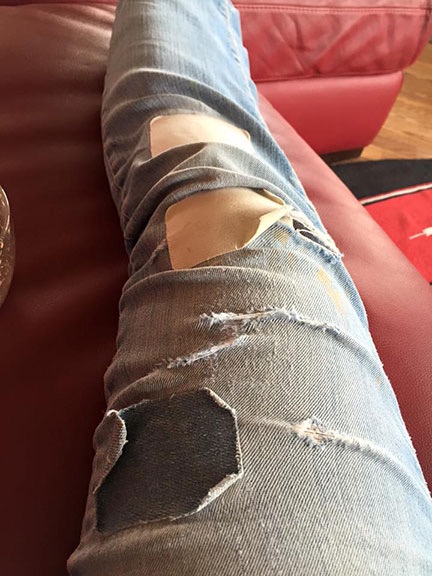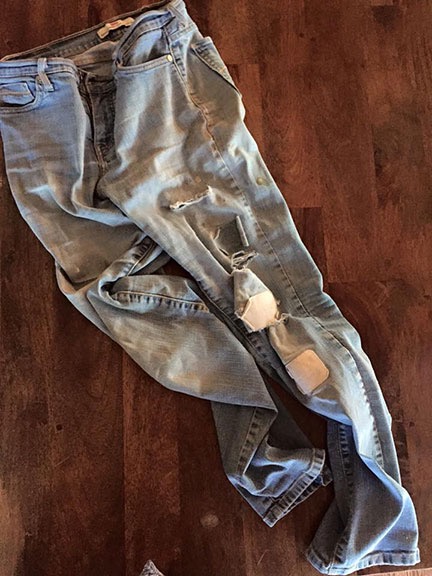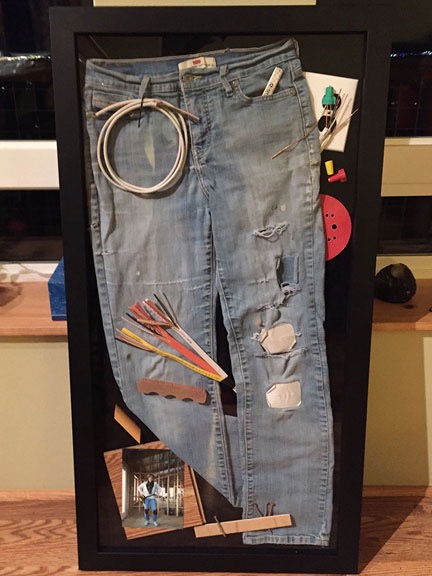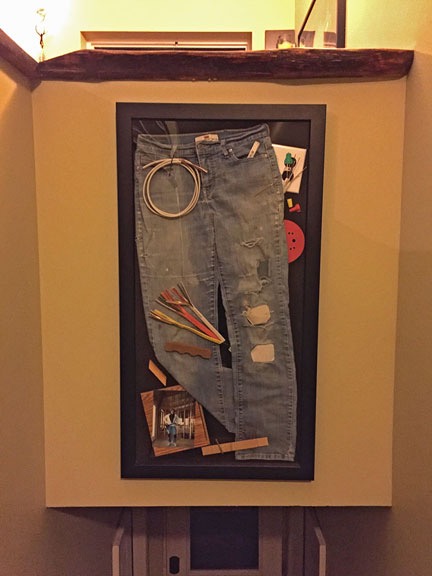It might sound goofy, but I framed the pants I wore throughout most of my construction project.

My pants didn’t look nearly as ratty here as they ended up.
Back in January, 2015, in a blog post about wiring my home, I shared a photo of myself dressed for winter wiring work inside my future home. In the photo, I was wearing a pair of Levi’s that would become my official work pants. Over the following months, I’d slowly but surely destroy them simply by wearing them while working.
They became my work pants when I wiped spray form insulation on them. Do you know the stuff I’m talking about? It comes in a can and you spray it through a narrow straw into cracks. I was working in the autumn of 2014 with my friend Barbara, spraying foam into the cracks around my windows and the doors to my deck. I got some of the spray on my finger and wiped it on my pants. Not sure why I did that — I should have known that it would never come off. It became a crusty yellow stain on the outside of my left thigh.
The pants, which I’d gotten from my brother for Christmas in 2012, already had a patched hole in the left thigh. The hole had manifested itself early on, almost as if by design. I know it’s fashionable — or maybe it was fashionable? — to have torn jeans, but I prefer mine intact. But this hole was just the first of many in that leg. (They don’t seem to make jeans the way they used to.) I patched them with iron-on patches as quickly as they appeared, but I never seemed to keep up with them.

Here’s what the jeans looked like on May 7, 2015.
On May 7, I shared another photo of the jeans, this time on Facebook. My update text read:
Heavily patched and washed three times each week, I’m determined to make these designated work pants last until my home is done. I might frame them when I’m done.
I think I was kidding about the framing.

Here’s a closeup of the torn up leg on June 1, 2015.
On June 1, I shared a closeup of the torn pants leg stretched out on my red leather sofa. I couldn’t seem to prevent them from ripping. By this point, the fabric on the legs and butt was so thin that I had to be careful putting them on. I said:
It’s a good thing this project is almost done — I don’t think these pants would last through many more washings.
Somewhere along the line, I’d managed to get paint on them. That was okay. The best thing about work pants is that you don’t have to worry about getting them dirty. They become the rag you don’t have handy when you need a rag. It kind of reminds me of when I was a kid and my dad painted houses as a second job. His old police work pants became his painting pants and were soon covered with all colors of paint.

I took what I thought would be the final photo of the jeans in August 2015. You can see the original yellow insulation stain on the back side of the left leg’s outer seam.
By August 31, it was all over — even though my construction project wasn’t. (To be fair, it was mostly done and I’d gone into a slow motion completion mode fueled by procrastination, which I excel at.) I shared a photo on Facebook with the comment:
After much soul- searching, I have decided to permanently retire my work pants.
The comments came quickly.
One person (Mandy H) suggested cutting them up and sewing them together as a bag. But the fabric was so thin, I didn’t think it would last, even as a bag.
Another person (Mike B) suggested:
Frame them as a memento of your hard work to build your new home and life.
I replied that I’d thought about that but that I had enough stuff. (I actually have far more than enough stuff.)
He replied:
Nothing signifies the amount of hard work than worn out work pants.
I certainly couldn’t argue with that. The pants had seen every aspect of my construction project.
Another person (Jorja) said:
Save them…………they won’t take up much space………you worked hard……….they deserve to stay………..a while longer!
The clincher was when another friend (Shirley) added:
Yeah, I’m thinking you should frame them as part of your house building memories. :-)
I decided to look into framing them. I’d need a shadowbox frame for them, so I went to Craft Warehouse, which had done some framing for me before. The price quote I got gave me serious sticker shock: $350. Ouch!
So I went online. I wound up spending about half that for a shadowbox frame “kit” that included the completely assembled frame with glass, felt backing, and hanging hardware. The box came about two weeks later.
And sat in my garage for a few months.
Meanwhile, I’d washed the pants one final time and had folded them neatly to wait for when I had time to frame them.
Last week, I did some garage cleaning and stumbled upon the box with the frame in it. I brought it upstairs and opened it. It looked like a big project.
I put off doing it for a few days.
I needed a photo, I decided. A photo to put the pants in context. I found the photo at the top of this blog post and emailed it to the local Walgreens photo department. I ordered a 5×7 print. I picked it up the next day.
Yesterday, I got tired of seeing the frame standing in the corner of my living room. I laid it out on my big dining table, disassembled it, and stretched out the pants. I put a fold in one leg to make room for the photo. I attached the jeans to the felt board by punching holes in them and running black wire ties behind them, out of sight. I used tape behind the photo to attach it to the felt and stood back to admire my work.
It looked boring. Flat.
I thought about what I could add to liven it up. How about a piece of Pergo under that photo? After all, I’d been wearing them when I laid 1200 square feet of Pergo laminated flooring.
And wire, of course. I’d done about 95% of the wiring in my home. How many days had I spent on the floor, creating grounding wire pigtails for outlets to satisfy the electrical inspector? One of those pigtails would be nice to show.
I went down into my shop and started poking around at material scraps.
The deck. I’d laid about 600 square feet of composite decking material. Maybe a piece of that? I’d thrown most of the scraps away, but still had a piece I could cut for a cross-section.
And quarter round trim? I was still laying that around the house so there were plenty of tiny scraps around.
And some of the many different types of screws? Wall screws, wood screws, deck screws, self-tapping screws. T-25 heads, T-15 heads, Philips heads. I grabbed a few.
And a sanding wheel from my orbital sander? I’d been doing a lot of sanding lately, working on my loft rails. I had at least a dozen spent wheels in the trash.
And of course, the stub of a pencil which seldom seemed handy when I needed it. I found two small ones in a pencil jar on my workbench and grabbed one of them.

Here’s the final piece, standing against the wall before hanging.
I began laying out all these things on the black felt “canvas.” I liked the way it was looking. But how to attach them? I had a small glue gun someplace.
I lost hours looking for it and getting distracted by other things. Just when I though I’d lost it and reached for a tube of silicone sealer, I decided to look into the toolbox drawer labeled “Adhesives.” Duh. I’d put it away. I brought it upstairs and got to work.
When I was done, it looked a lot busier. But not too busy, I think.

The pants, hung on my wall.
I already knew where I was going to hang it. Although my first thought was to hang them in the bedroom, on the wall I was standing in front of in the photo at the top of this blog post, I wanted to put it in a place where everyone would see them, a place where they could become a conversation piece. There was a big piece of empty wall over the stairs that was the right size and shape. I did some measuring and used the heavy-duty picture hanger that had come with the frame to hang the finished piece there.
It looked good.
I’m very glad that my friends — especially Mike, Jorja, and Shirley — talked me into keeping these jeans and making them into a piece of personal memorabilia. I put a lot of work into my home and I’m still amazed, every day, at how good it came out. These pants, framed with a few other mementos of that work, will remind me what it took to get it done.
On May 20, 2014, I began blogging about the construction of my new home in Malaga, WA. You can read all of these posts — and see the time-lapse movies that go with many them — by clicking the
new home construction tag.
Once free to do what I wanted to do, the way I wanted to do it, I made it happen. I’ll remember that every time I see this piece.
Would I do it again? A few months ago, I would have said no. But now I’m starting to think that this was just practice for my next home.



